Making Arak ...
Finally I'm going to write about how we make Arak in Toula, my friend Graham wants it online, online it will go. [This work is copyrighted, which I naively understand as the right to copy - that is to say, anyone can copy/modify at will].
Arak is an aniseed flavoured distilled alcohol. It's the main alcoholic drink of Lebanon. Toula is known for the number of many artisanal Arak makers, who prepare Arak for their own consumption. Therefor the quality is much higher then the finest commercial Arak.
Usually the preparation of Arak is kind of celebrated with a party, lot's of amazing Lebanese food, lot's of drinking and socializing.
When I visited Toula the end of last summer, I attended one of those evenings, and of course had my share of the product at the end.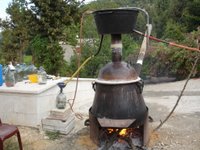
The main tool used is a sort of Alembic called Karkeh (in the Lebanese dialect). The main idea is to extract the alcohol out of the mix.
Here we can find a photo of the Karkeh, running full speed!
Scientifically what's happening is not so complicated, the device is something like this diagram.

Note that in the picture the product coming out to the left, while in the diagram it's coming out to the right.
So the mix is heated in the lower black part. It evaporates and then is cooled on the top black part, by a stream of cold water.
The final liquid is collected in a glass gallon.

Now, the Arak making is quite a long process, we can start by harvesting the vine grapes. Than the grapes are squeezed to make the juice come out. The whole is put in barrels for two or three weeks (depending on the temperature) to make sure the fermentation process is completed. The mixture is called Mestar. It is usually stirred every other day to make sure that all the organic vapours do not get stuck in the lower parts.
First distillation
After the fermentation is complete, the mix (all the squeezed vine grapes and the juice that have completed the fermentation) is put in the lower part of the karkeh.
A first distillation is done, and the product is alcohol, this is not Arak, just raw alcohol that cannot be drank.
In my last visit I didn't attend the first part of the process... What I witnessed (only this time, I've seen the whole thing times and times before) starts from here, the raw material being this alcohol.
Setting the stage for the 2nd distillation
The lower part of the karkeh is filled with a mixture of the raw alcohol we have:




Just some terminology, the jargon used:
The raw alcohol here is called spirto. It is remarkably close to the term spirits the western word for alcoholic drinks. This could be well a word taken from the French during their mandate of the region in the beginning of the 20th century.
The black lower part is called desset.

Ok, so now water and aniseed will be added too.


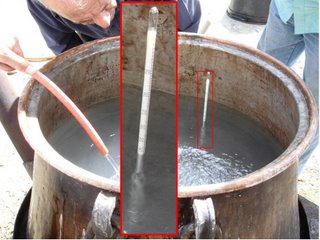
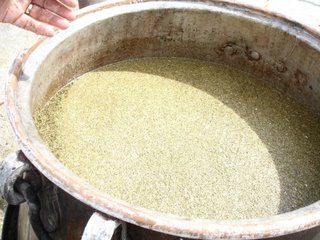 water is added to reduce the alcohol, and extend the 2nd distillation, this gives more time to the final product to be well flavored by the aniseed. Also water is added to make sure that the alcohol rate is not too high. Again this is a factor in the taste of the Arak.
water is added to reduce the alcohol, and extend the 2nd distillation, this gives more time to the final product to be well flavored by the aniseed. Also water is added to make sure that the alcohol rate is not too high. Again this is a factor in the taste of the Arak.
The meter used, is based on the mass to volume ratio, alcohol being lighter than water, the more alcohol the lighter the liquid, the more the device goes deeper in the liquid. And you can read the degree of alcohol. I was told that for normal whisky the number is 40. Which is the number we see written on the most whisky bottles. I didn't double check this.

Now assembling the karkeh is next:
a paste of flower and water is used to keep the vapors inside.

The top is filled with cold water to cool the vapor and transform it into liquid..


The whole is heated to a temperature just below 100 degree celcius, so that only alcohol evaporates and is collected.
Toward the end of the process, when the alcohol concentration decreases, more water is collected at the other end, this can be noticed by the color of the mix collected, which turns into white.
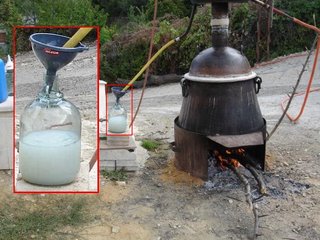
at this point the karkeh is disassembled and the desset is emptied and cleaned:
first the paste is removed
 then the upper part is removed
then the upper part is removed
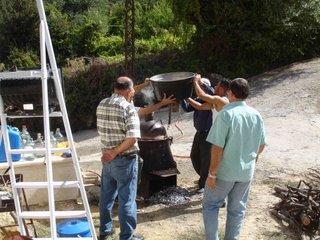 then the middle part
then the middle part
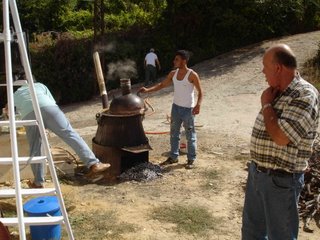
then the lower part is emptied:
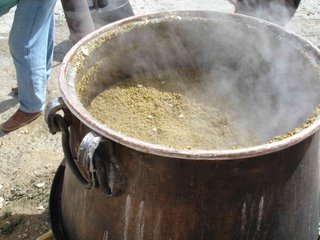

after that the whole is cleaned and so on...
the final product, is finest quality Arak:
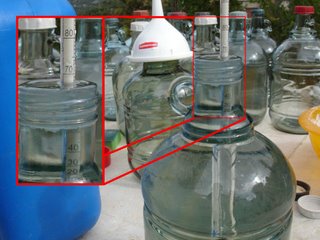
Careful with that... it's 70 percent of the volume...
That was a rather technical post, the fun and the embiance is very hard for me to reproduce.
Arak is an aniseed flavoured distilled alcohol. It's the main alcoholic drink of Lebanon. Toula is known for the number of many artisanal Arak makers, who prepare Arak for their own consumption. Therefor the quality is much higher then the finest commercial Arak.
Usually the preparation of Arak is kind of celebrated with a party, lot's of amazing Lebanese food, lot's of drinking and socializing.
When I visited Toula the end of last summer, I attended one of those evenings, and of course had my share of the product at the end.

The main tool used is a sort of Alembic called Karkeh (in the Lebanese dialect). The main idea is to extract the alcohol out of the mix.
Here we can find a photo of the Karkeh, running full speed!
Scientifically what's happening is not so complicated, the device is something like this diagram.
Note that in the picture the product coming out to the left, while in the diagram it's coming out to the right.
So the mix is heated in the lower black part. It evaporates and then is cooled on the top black part, by a stream of cold water.
The final liquid is collected in a glass gallon.

Now, the Arak making is quite a long process, we can start by harvesting the vine grapes. Than the grapes are squeezed to make the juice come out. The whole is put in barrels for two or three weeks (depending on the temperature) to make sure the fermentation process is completed. The mixture is called Mestar. It is usually stirred every other day to make sure that all the organic vapours do not get stuck in the lower parts.
First distillation
After the fermentation is complete, the mix (all the squeezed vine grapes and the juice that have completed the fermentation) is put in the lower part of the karkeh.
A first distillation is done, and the product is alcohol, this is not Arak, just raw alcohol that cannot be drank.
In my last visit I didn't attend the first part of the process... What I witnessed (only this time, I've seen the whole thing times and times before) starts from here, the raw material being this alcohol.
Setting the stage for the 2nd distillation
The lower part of the karkeh is filled with a mixture of the raw alcohol we have:




Just some terminology, the jargon used:
The raw alcohol here is called spirto. It is remarkably close to the term spirits the western word for alcoholic drinks. This could be well a word taken from the French during their mandate of the region in the beginning of the 20th century.
The black lower part is called desset.

Ok, so now water and aniseed will be added too.



 water is added to reduce the alcohol, and extend the 2nd distillation, this gives more time to the final product to be well flavored by the aniseed. Also water is added to make sure that the alcohol rate is not too high. Again this is a factor in the taste of the Arak.
water is added to reduce the alcohol, and extend the 2nd distillation, this gives more time to the final product to be well flavored by the aniseed. Also water is added to make sure that the alcohol rate is not too high. Again this is a factor in the taste of the Arak.The meter used, is based on the mass to volume ratio, alcohol being lighter than water, the more alcohol the lighter the liquid, the more the device goes deeper in the liquid. And you can read the degree of alcohol. I was told that for normal whisky the number is 40. Which is the number we see written on the most whisky bottles. I didn't double check this.

Now assembling the karkeh is next:
a paste of flower and water is used to keep the vapors inside.

The top is filled with cold water to cool the vapor and transform it into liquid..


The whole is heated to a temperature just below 100 degree celcius, so that only alcohol evaporates and is collected.
Toward the end of the process, when the alcohol concentration decreases, more water is collected at the other end, this can be noticed by the color of the mix collected, which turns into white.

at this point the karkeh is disassembled and the desset is emptied and cleaned:
first the paste is removed
 then the upper part is removed
then the upper part is removed then the middle part
then the middle part
then the lower part is emptied:


after that the whole is cleaned and so on...
the final product, is finest quality Arak:

Careful with that... it's 70 percent of the volume...
That was a rather technical post, the fun and the embiance is very hard for me to reproduce.
